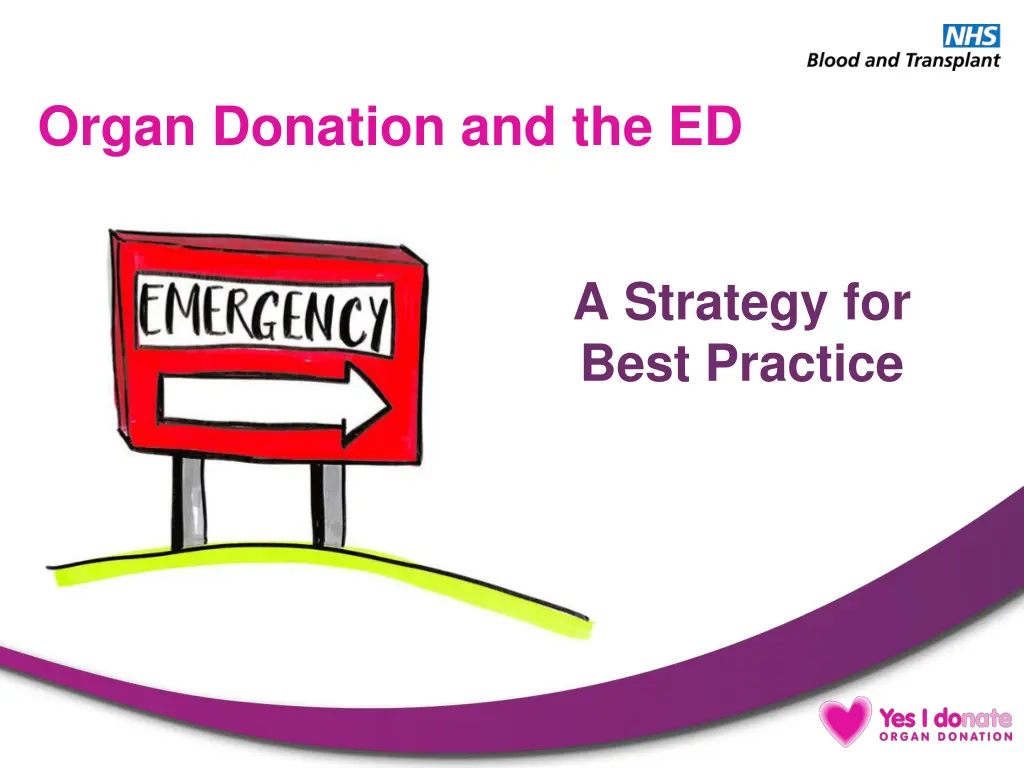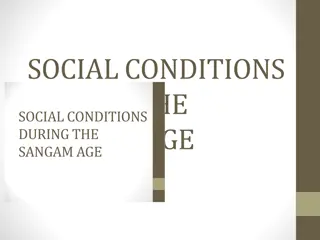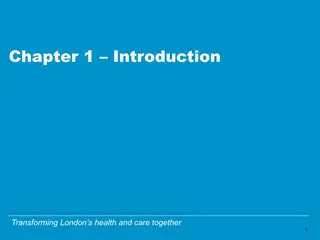
Organ Donation in Emergency Departments: Best Practices & Strategies
Learn about the critical role Emergency Departments play in organ donation, the challenges faced by clinicians, and best practices for identifying and referring potential organ donors. Explore how healthcare professionals navigate the sensitive process of discussing organ donation with patients' families during end-of-life care.
Download Presentation

Please find below an Image/Link to download the presentation.
The content on the website is provided AS IS for your information and personal use only. It may not be sold, licensed, or shared on other websites without obtaining consent from the author. If you encounter any issues during the download, it is possible that the publisher has removed the file from their server.
You are allowed to download the files provided on this website for personal or commercial use, subject to the condition that they are used lawfully. All files are the property of their respective owners.
The content on the website is provided AS IS for your information and personal use only. It may not be sold, licensed, or shared on other websites without obtaining consent from the author.
E N D
Presentation Transcript
Organ Donation and the ED A Strategy for Best Practice
UK Transplants and the Transplant Waiting List 2002 - 2016 9000 Transplant waiting list 8000 7000 Transplants from Deceased and Living Donors 6000 Transplants from Deceased Donors 5000 Transplants from Living Donors 4000 3000 Three people die in the UK EVERYDAY waiting for a transplant 2000 1000 0 Organ Donation and the ED
Preface Many critically ill patients enter the hospital through the Emergency Department. Emergency physicians and nurses are firstly concerned with resuscitation of these patients. We also recognise that some will have such severe illness or injury that they will not survive. The emergency department becomes the first stage of an emotional journey for the relatives. Clinicians working in the emergency department face many challenges as they help the family understand the unfolding tragedy. 2016 Most patients who go on to become organ donors start their journey in the emergency department and the question of when to explore this opportunity for the patient can be difficult for clinicians and potentially cause conflict among them. Deceased donation is important, not just for those people waiting on the transplant list, but also because many people have made an express wish to become organ donors after their death. Nursing staff and emergency physicians must understand this and support their patients and families to explore this wish at the end of life. This strategy guide presents best practice in how clinicians should make decisions about the withdrawal of treatment and describes the important legislation and ethical support for the identification and referral of the potential organ donor in the emergency department, building on the Royal College of Emergency Medicine, End of Life Care Best Practice Guide. Furthermore, it practically describes best practice in approaching the family of the potential donor. Dr Tajek Hassan President of the Royal College of Emergency Medicine Organ Donation and the ED
Royal College of EM A senior named ED clinician should be involved with and responsible for every end of life care patient. This will usually be the ED Consultant but may be an ST4 or above out of hours, who should discuss such patients with their Consultant by minimum. 2015 phone as a Organ Donation and the ED
St Elsewhere Young man, high speed traumatic head injury. Within an hour of arrival in ED - declared non survivable by neurosurgery. Family approached for donation by ED consultant whilst SNOD enroute. Family very keen for donation No ICU beds available in the hospital, but available in another hospital in the same trust. SNOD confirmed donation with the family and also the coroner at ICUs request prior to transferring the patient to the sister hospital. On arrival to ICU, patients GCS started improving, strong spontaneous cough. ICU consultant felt best to pause process GCS improved further overnight. Decision to transfer him back to the neurocentre and treat. Discharged home. Family are okay with everything, very thankful donation delayed treatment withdrawal! Organ Donation and the ED
Neurocritical Care Society Guidance (USA) We repeated examinations over time to establish greater confidence and accuracy. recommend from determining prognosis 2015 2016 A case for stopping the early withdrawal sustaining therapies patients with brain injuries. of life in devastating Souter et al. (2015) Neurocritical Care; 23: 4 13. Manara A, Thomas I and Harding R. (2016) JICS 14(4): 295-301. Organ Donation and the ED
vs Organ Donation and the ED
Before becomes part of a patient s end of life care in the ED, it must be robustly established that further life-sustaining treatment is not of overall benefit to the patient. Any decision to withdraw life- sustaining treatment should be made by two senior doctors. deceased donation 2016 Organ Donation and the ED
General Medical Council Organ donation 81 If a patient is close to death and their views cannot be determined, you should be prepared to explore with those close to them whether they had expressed any views about organ or tissue donation, if donation is likely to be a possibility. 2010 82You should follow any national procedures for identifying potential organ donors and, in appropriate cases, for notifying the local transplant coordinator. Establishes a duty on doctors to explore donation and follow national procedures. Organ Donation and the ED
Royal College of EM 1. Opportunities for organ and tissue donation should be considered as a usual part of end of life care in the Emergency Department. ED staff should refer all patients who are expected to die, and who are intubated and ventilated, to their local Specialist Nurse in Organ Donation (SNOD). Referral to the SNOD should be as early as possible as they can offer valuable support and guidance for the team and family. The SNOD will assess patient suitability for organ donation and approach the patient s next of kin for consent, if appropriate. 2. 2015 3. Organ Donation and the ED
2012 Refer to SNOD Plan to withdraw life- sustaining treatment in a mechanically ventilated patient. 2011 16% of the patients who died in ED and were NOT referred as potential donors were registered as donors on the NHS Organ Donor Register. 1st April 2012 31st March 2016 Organ Donation and the ED
Died in Emergency Department meeting PDA referral criteria 1st April 2016 to 31st March 2017 5 Number of patients 4 3 2 1 0 London Referral
Died in Emergency Department meeting PDA referral criteria 1st April 2016 to 31st March 2017 5 Number of patients Not Referred Strategy Goal: No one died in your ED meeting referral criteria and was not referred. (NO BLUE) 4 Referred 3 2 1 0 London Referral
Donation is ONLY raised after confirming the families understanding and acceptance of loss. Planning 2012 Confirming understanding and acceptance of loss Discussing donation Organ Donation and the ED
Families approached regarding organ donation in the ED 1st April 2016 to 31st March 2017 5 Number of patients 4 3 2 1 0 Family Approaches - London
Families approached regarding organ donation in the ED 1st April 2016 to 31st March 2017 5 Strategy Goal: No family approached in ED regarding organ donation without a SNOD. (NO RED) Number of patients 4 3 2 NO SNOD involved in approach 1 SNOD involved in approach 0 Family Approaches - London
2016 Organ Donation and the ED





















